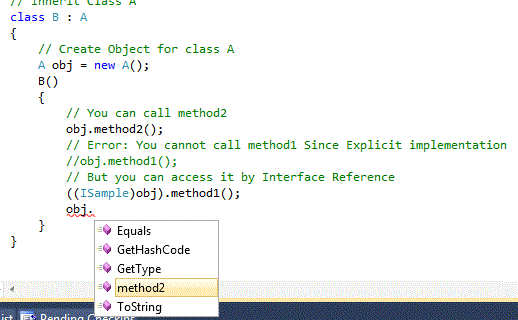Introduction
There are 2 types of interface implementations available in C#. One is Implicit and another one is Explicit. This tip explains the purpose of the "Explicit" implementation of Interfaces.
Background
Interfaces are the one of the best language features in C#, which helps to achieve the run time polymorphic feature. Every programmer has experience with interfaces, with implicit implementation, which is normal. This article talks about another way of implementation and its purposes.
Using the Code
There are 2 purposes of explicit implementation of Interface:
First, it is used to avoid name collision between interface methods. That is if you are going to create a class library, there may be a chance to use the same name in several places. At that time "explicit" implementation comes as a rescue.
Secondly, You cannot access that implemented method through the object of the class directly. Instead you typecast it as Interface reference then you can access it. This is because, the C# compiler, unable to determine which one the user want to call.
In another way, you need to add "public" access specifier in the interface's implemented method in a class. But if you "explicitly" implemented the interface, you can change this one. That means, it will be look alike private method. But with one exception, you can access that explicit implemented method through the reference of the interface. Please take a look at the below code for a detailed explanation:
interface ISample
{
void method1();
void method2();
}
interface IAnotherSample
{
void method1();
}
class A : ISample, IAnotherSample
{
void ISample.method1()
{
}
void IAnotherSample.method1()
{
}
public void method2()
{
}
}
class B : A
{
A obj = new A();
B()
{
obj.method2();
((ISample)obj).method1();
}
}
Finally, one more point, explicitly implemented interfaces' methods are not listed down in the Visual Studio IDE's intellisense.

Readers, do you have any thoughts/opinions, please write your comments below!!
 General
General  News
News  Suggestion
Suggestion  Question
Question  Bug
Bug  Answer
Answer  Joke
Joke  Praise
Praise  Rant
Rant  Admin
Admin 







